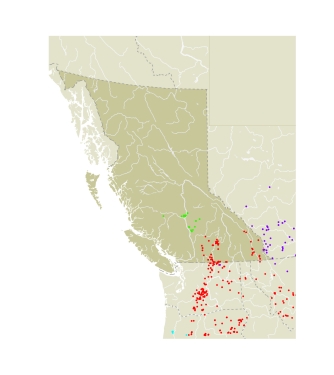AdultThe common and widely distributed subspecies S.c. semivirida is distinguished by the fact that the ground colour of the ventral hindwing is overcast with green. The new subspecies described below cannot be confused with any other BC Speyeria species. It could, however, be confused with S. egleis, a species not yet known from BC.
Immature StagesThe mature larva is black. The body is covered with protuberances that bear spines. There are two mid-dorsal narrow yellow stripes. S. callippe and S. zerene are identical in the larval stages.
SubspeciesThe Green Fritillary, S.c. semivirida (McDunnough, 1924) (TL: Aspen Grove, BC) is found in southeastern BC. The ventral hindwings have a green ground colour. In the Chilcotin Fritillary, described below, the ventral hindwings have a brown ground colour.
Speyeria callippe chilcotinensis Guppy & Shepard, new subspecies. In both males and females of S.c. chilcotinensis the ground colour of the ventral hindwings is dark chocolate brown, rather than the green of S.c. semivirida. Also, the ground colour of the ventral forewings of both sexes is primarily a reddish brown. S.c. semivirida, by contrast, has fewer reddish brown scales and the ground colour is much lighter. Types. Holotype: female, BC, Riske Creek, 23 July 1981, J. and S. Shepard. A label "Holotype / Speyeria callippe / chilcotinensis Guppy & Shepard" is attached. The holotype is deposited in the Royal British Columbia Museum, Victoria, BC, CAN. Paratypes: 2 males, BC, Riske Creek, 27 June 1970, J. and S. Shepard (JHS); 3 females, same locality, 23 July 1981, J. and S. Shepard (JHS); 1 male, 1 female, BC, Pavilion, 10 mi. N., 18 July 1981, J. and S. Shepard (JHS); 2 males, BC, 70 Mile House, 1 July 1972, S. Shepard (JHS); 2 males, BC, Jesmond Lookout, el. 6,000', 29 July 1972, S. Shepard (JHS); 1 male, BC, Riske Creek, Deer Park Ranch on Moon Road, 21 June 1997, A.I. Fischer (CSG); 1 male, BC, Riske Creek, Becher's Prairie, 24 June 1997, A.I. Fischer (CSG); 1 male, BC, Riske Creek, Moon Road, 24 June 1997, A.I. Fischer (CSG); 1 male, BC, Riske Creek, Hwy 20, 25 June 1997, A.I. Fischer (CSG); 3 males, BC, Riske Creek, road to Farwell Canyon, 12 July 1997, A.I. Fischer (CSG); 1 female, BC, Williams Lake, south of town, 12 July 1997, A.I. Fischer (CSG); 1 male, BC, Riske Creek, west of road to Farwell Canyon, A.I. Fischer (CSG); 3 males, 1 female, BC, Riske Creek, Becher's Prairie, East Lake, 12 July 1997, A.I. Fischer (CSG); 3 males, BC, Riske Creek, Cotton Road, 12 July 1997, A.I. Fischer (CSG); 2 males, 1 female, BC, Riske Creek, Doc English Gulch, 20 July 1997, A.I. Fischer (CSG); 1 female, BC, Riske Creek, Stack Valley Road, 10 August 1997, A.I. Fischer (CSG); 1 male, BC, Hanceville, 25 km east at Harper Lake, 12 July 1997, A.I. Fischer (CSG).
